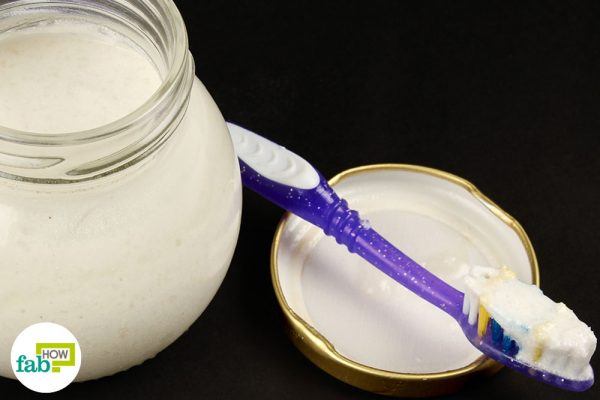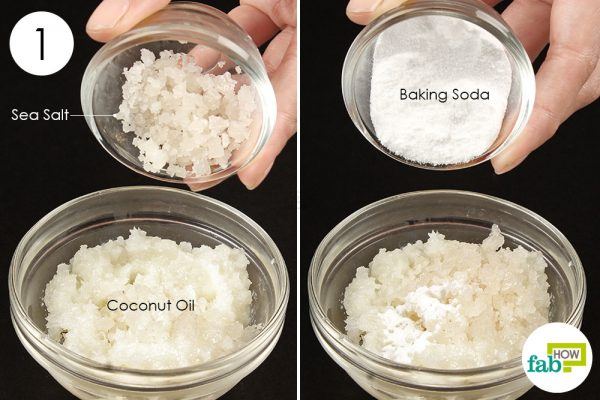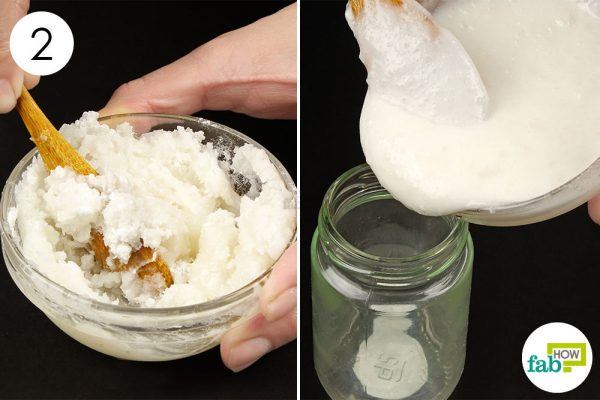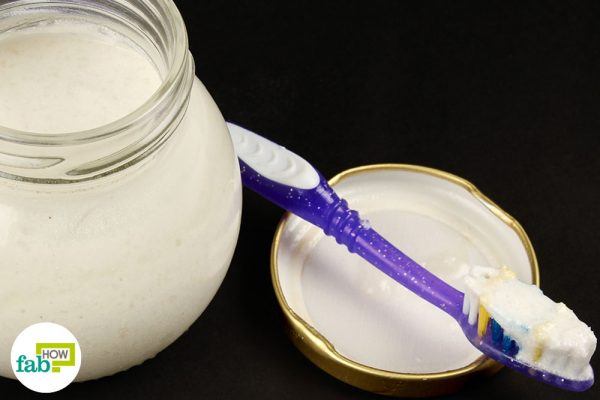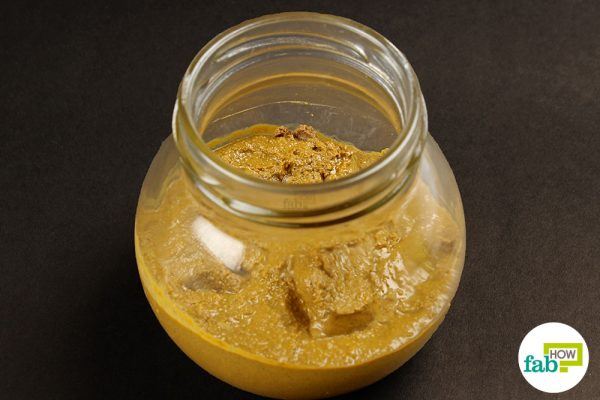While the rural population in many parts of the world still resorts to natural methods like sea salt, baking soda, coconut oil, and wood ash as an alternative for toothpaste, most others rely upon a tube of some magic ingredients to whiten and clean their teeth and gums.
However, do you realize the number of toxins you may be taking in from the conventional toothpaste? Take a look at some of the ingredients used in commercial toothpastes, and you’ll come to understand that just because something is sold in stores everywhere doesn’t mean it’s healthy for you.
The most common ingredients found in commercial toothpaste include:
- Triclosan - A pesticide and hormone disruptor.
- Artificial dyes - Potentially linked to attention-deficit/hyperactivity disorder (ADHD) in children.
- Sodium fluoride - Toxic if swallowed.
- Sodium lauryl sulfate - Causes canker sores in many.
- Artificial sweeteners - Linked to some serious health problems.
- Sorbitol - A liquid that prevents toothpaste from drying out, but has laxative effects that can cause diarrhea.
If health is a concern for you, you’d better switch to natural toothpaste – free from toxins and harmful components – that not only whiten and clean your teeth but also promote overall oral health.
Here are three methods to make your own natural toothpaste at home.
Contents
Method 1: Use Coconut Oil, Baking Soda, and Sea Salt
Coconut oil helps to boost the microbiome in the gut and thus naturally prevents candida in the mouth. It also helps reduce cavity-causing bacteria in the mouth. (1)
Alkaline in nature, baking soda neutralizes the acids to maintain a proper pH in the mouth. It also acts as a mild abrasive. (2)
Sea salt adds extra minerals as well as an additional abrasive texture that helps brush plaque off your teeth.
Things you’ll need:
- Coconut oil – 3 tablespoons
- Baking soda – 1 tablespoon
- Sea salt – 1 tablespoon
Step 1. Add sea salt and baking soda to coconut oil
- Start with 3 tablespoons of coconut oil in a bowl.
- Add 1 tablespoon of sea salt.
- Add 1 tablespoon of baking soda to the mixture as well.
For added benefits, you can also add a few drops of clove or peppermint essential oil.
Step 2. Combine the ingredients, store, and use
- Combine the ingredients well to form a smooth paste.
- Store the paste in a bottle and use it to brush your teeth twice a day.
Method 2: Use Coconut Oil and Calcium Powder
Coconut oil contains incredible healing, antiseptic and antibacterial properties that help fight germs in your mouth and reduce cavities in your teeth. (1)
Xylitol, natural alcohol, helps prevent dental caries, maintaining oral health. (3)
The alkaline nature of baking soda neutralizes the acids in the mouth that contribute to tooth decay. (2)
Calcium powder makes the teeth healthy and strong by adding minerals calcium and magnesium. (4)
Clove essential oil kills fungi and bacteria and improves the overall health of the teeth. (5)
Things you’ll need:
- Coconut oil – 4 tablespoons
- Baking soda – 2 tablespoons
- Xylitol powder – 1 tablespoon
- Clove oil – 2 tablespoons
- Calcium powder – 2 tablespoons
Step 1. Put coconut oil in a bowl and add the other ingredients
- Put 4 tablespoons of coconut oil in a bowl.
- Add 2 tablespoons of calcium powder to the coconut oil.
- Blend in 2 tablespoons of baking soda and 1 tablespoon of xylitol powder.
- Pour 2 tablespoons of clove oil into the blend.
Step 2. Combine well, store and use
- Mix all the ingredients thoroughly to form a paste.
- Store in a container and use as a regular toothpaste to keep your teeth healthy and reduce the risk of cavities.
Method 3: Use Bentonite Clay
Bentonite clay, a natural polisher, helps clean and polish your teeth without damaging the protective enamel. Alkaline in nature, bentonite is rich in minerals that are not too abrasive and helps reduce acidity in the mouth. (6)
While trace mineral drops help remove the bad stuff from the water used in the toothpaste, xylitol helps to reduce harmful cavity-causing bacteria in the mouth. (3)
Coconut oil contains amazing antibacterial and antifungal properties that help destroy the bacteria that cause cavities and gum disease. (1)
Clove and peppermint essential oils boast powerful antibacterial and antifungal properties that promote oral health. (5)
Things you’ll need:
- Bentonite clay – ½ cup
- Concentrated trace minerals – 8 to 10 drops
- Xylitol powder – 2 tablespoons
- Coconut oil – 2 tablespoons
- Clove essential oil – 8 to 10 drops
- Peppermint essential oil – 8 to 10 drops
- Water – 1 tablespoon
Step 1. Combine the dry ingredients in a bowl
- Put ½ cup of bentonite clay in a bowl.
- Add 2 tablespoons of xylitol powder to it.
Step 2. Blend in the liquid ingredients
- Add 2 tablespoons of coconut oil to the mixture.
- Add 8 to 10 drops each of clove essential oil, peppermint essential oil, and trace mineral drops to the mixture.
Step 3. Mix the ingredients well
- Mix all the ingredients thoroughly.
Step 4. Mix in some water, store and use
- Sprinkle about 1 tablespoon of water into the mixture and mix again until you acquire a thick but smooth consistency.
- Store the homemade toothpaste in a jar, and use it regularly to maintain good oral health.
Tips to make DIY toothpaste
- Xylitol is a sweetener, so do not add too much of it to the toothpaste, as it can cause your taste buds to crave too many sweets.
- When working with calcium powder, use a container that is not airtight. An airtight container can cause a pressure reaction.
- Do not fret if you see some reactions after using homemade bentonite clay toothpaste for the first few days. Clay binds and pulls out toxins, so this is normal and will subside soon.
- For sensitive teeth, fillings, veneers or children, it is best to check with a dentist before changing the dental products and routine.
Resources:
- Naseem M, Khiyani MF, et al. Oil pulling and the importance of traditional medicine in oral ... International Journal of Health Science. https://www.researchgate.net/publication/320765791. Published January 2017.
- Chandel S, Khan MA, Singh N, Agrawal A, Khare V. The effect of sodium bicarbonate oral rinse on salivary pH and oral microflora: A prospective cohort study. National Journal of maxillofacial surgery. https://www.ncbi.nlm.nih.gov/pmc/articles/PMC5773983/. Published 2017.
- Nayak PA, Nayak UA, Khandelwal V. The effect of xylitol on dental caries and oral flora. Clinical, cosmetic and investigational dentistry. https://www.ncbi.nlm.nih.gov/pmc/articles/PMC4232036/. Published November 10, 2014.
- Meyer F, Amaechi BT, Fabritius H-O, Enax J. Overview of Calcium Phosphates used in Biomimetic Oral Care. The open dentistry journal. https://www.ncbi.nlm.nih.gov/pmc/articles/PMC5997847/. Published May 31, 2018.
- Marya CM, Satija G, J A, Nagpal R, Kapoor R, Ahmad A. In vitro inhibitory effect of clove essential oil and its two active principles on tooth decalcification by apple juice. International journal of dentistry. https://www.ncbi.nlm.nih.gov/pmc/articles/PMC3432374/. Published 2012.
- Stojiljković ST, Stojiljković MS. Application of Bentonite Clay for Human Use. SpringerLink. https://link.springer.com/chapter/10.2991/978-94-6239-213-7_24. Published January 17, 2017.
Summary of How to Make Toothpaste (Natural, Non-Toxic and Fluoride-Free)
Download this infographic.


